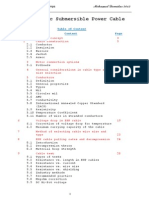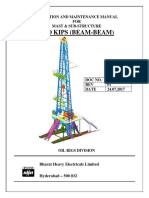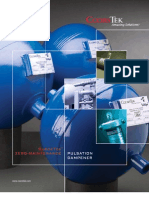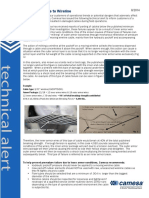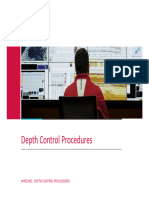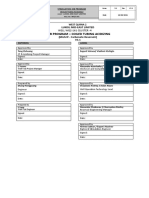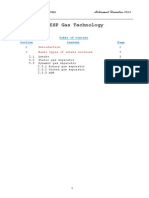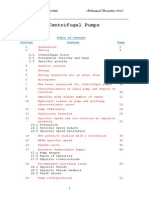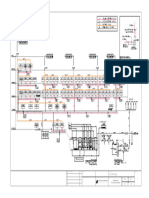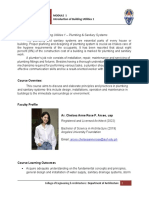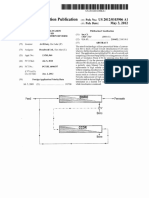JP - Chapter 02
JP - Chapter 02
Uploaded by
dewidar1234Copyright:
Available Formats
JP - Chapter 02
JP - Chapter 02
Uploaded by
dewidar1234Original Title
Copyright
Available Formats
Share this document
Did you find this document useful?
Is this content inappropriate?
Copyright:
Available Formats
JP - Chapter 02
JP - Chapter 02
Uploaded by
dewidar1234Copyright:
Available Formats
Hydraulic Jet Pumps Mohamed Dewidar
1
Chapter 02
Hydraulic Jet Pumps
Surface equipment package for hydraulic pumping
applications.
It provides complete fluid conditioning as well as a surface pump to provide
pressurized power fluid to the down-hole pump.
It is designed for continuous operation and will perform satisfactorily when properly
set, adjusted and maintained. Periodic inspections and repairs will be required.
The end-user of the equipment must determine the intervals of inspections.
System Description
The fluid and gas Check Valve received from the producing well are fluids from the
formation and fluids that have been used to power the down-hole hydraulic pump
which have been co-mingled down hole.
Check valve
The fluids first enter the package through a check valve normally furnished by
the user of the equipment.
Accumulator Surge Vessel
The first entrance of fluids into the unit itself will be at the accumulator surge
vessel (25) (vertical separator). See the drawing below.
The purpose of the accumulator surge vessel (25) is to prevent excess gas
from entering the cyclone desander (9) causing cyclone desander inefficiency.
The vertical separator also serves as a surge chamber should the vessel be
subjected to a high-pressure kick from the well. It prevents the surge from
being transmitted to the cyclone desander and the conditioning vessel.
Surge Control Valve
The surge control valve (13) is set to open whenever a high-pressure surge is
sensed at the valve inlet (i.e. at the accumulation surge vessel). The valve is
normally set to open at a differential pressure of 40 psi. It can be adjusted to
sense other differentials if required.
If too much fluid is being by-passed in front of the cyclone desander (9) with
the surge valve (13) set to open at 40 psi differential, the surge valve (13) may
Hydraulic Jet Pumps Mohamed Dewidar
2
be set for a higher differential pressure (up to 45 psi). This will by-pass less
fluid through valve (13) and direct more fluid through the cyclone desander (9).
If no fluid or gas is being by-passed with the surge valve (13) is set to open at
a differential of 40 psi, the surge valve (13) may be set to open at a lower
differential pressure (35 psi minimum) so that gas and some liquid will by-
pass the cyclone desander.
The surge control valve can be converted to a back-pressure regulator by
isolating the pressure source to the top of the valve diaphragm and loosening
the adjusting screw sealing nut. When a back pressure greater than 60 psi is
required, a stronger spring must be installed.
Cyclone Desander
The cyclone desander is considered to be the very heart of the 9Unit. Without
excellent solids separation, unnecessarily short pump runs and excessive
multiplex maintenance will result.
The cyclone desander(s) (9) must be sized to effect maximum solid particle
separation and furnish essentially clean fluid for the surface power fluid pump
(29) and the down-hole hydraulic pump.
The solids separated by cyclone desander (9) are discharged downward
through the cyclone desander underflow and can be viewed through visual
sight glass (22).
The clean power fluid passes from the top (overflow) of the cyclone desander
(9), through the cyclone desander outlet valve (20) and on into the fluid
conditioning vessel (24) for further separation of gas, oil, and water.
Fluid Conditioning Vessel
The retention time of the power fluid in the conditioning vessel is not really
long enough for any appreciable settling of solids particles from the fluids, so
most solids separation must be done by the cyclone desander. This is what
makes proper installation, sizing, monitoring and operation of the cyclone
desander so important to the entire system operation.
Once the hydraulic system is operating, fluid in excess of that required by the
surface and subsurface pumps is discharged from fluid conditioning vessel
(24) through manual selector valve (3) (high outlet) for oil discharge, or
through valve (4) (low outlet) for primarily water discharge.
The amount of fluid discharge from conditioning vessel (24) is controlled by
the pressure differential between conditioning vessel (24) and flow line
pressure.
Hydraulic Jet Pumps Mohamed Dewidar
3
The level of liquids in the conditioning vessel is maintained at a high enough
level to supply the multiplex with adequate clean fluid.
Safety Valves
The Unit is equipped with two safety valves. There is a conditioning vessel
safety valve (10) and an accumulator safety valve (14). Each valve is set to
provide over-pressure protection for the vessels.
CAUTIONS
Never pipe the safety relief outlets back
into the flow line. If a downstream valve is
closed or the flow line plugs the whole
system will be over pressured, possibly
resulting in a ruptured vessel.
The safety valves are factory set to meet
vessel specifications and are sealed. They
are not to be adjusted in the field.
Power Fluid Pump
Fluid from the conditioning vessel is supplied to the surface power fluid pump
(29) (multiplex pump) which provides pressurized liquid to operate the
subsurface hydraulic pump. The power fluid pump is powered by an electric
motor, diesel, or gas engine.
Pulsation Dampener
A pulsation dampener (32) is installed near the multiplex discharge to
dissipate "fluid hammer" in the system which can develop due to the pulsating
multiplex output.
If the pressure fluctuations from the multiplex are not damped out, the fluid
hammer can become severe enough to actually break the wellhead
connections.
As the pulsating shock waves travel farther from the pump, the reflecting
shock wave becomes amplified. These amplified pulsations, if not damped
out, will also reflect back into the fluid power pump destroying the pump. For
this reason the pulsation dampener must be located as close as possible to
the multiplex discharge.
Hydraulic Jet Pumps Mohamed Dewidar
4
Manual By-pass Valve
The power fluid manual by-pass valve (15) regulates the volume of power fluid
which is diverted from the down-hole pump and circulated back into the Unit
as excess power fluid.
Since the multiplex displacement is greater than the volume required to
operate the subsurface hydraulic pump, some fluid must be by-passed. The
amount by-passed fluid must be adjustable so that the volume of injected
power fluid can be varied to regulate the hydraulic pumping speed.
Control Panel
The control panel is a standard oil-field type Murphy panel with indicators and
limit controls for safety, start up, operation, and shut down.
Component Description
Accumulator Surge Vessel
The accumulator surge vessel (25) provides ample storage capacity in the event
the well "heads-up" with gas. It separates the gas and cushions abnormally
high pressure surges.
Surge Control Valve
The surge control valve (13) will open when the valve inlet receives a high surge
of pressure.
When the volume of fluid processed is great enough to cause a 40 psi pressure
loss across the cyclone desander (9) the surge valve (13) will open and excess
gas and fluid will be removed from the accumulator surge vessel (25). This
results in a fluid level near the vessel top.
The valve may also be set for other differential pressures.
Cyclone Desander
The cyclone desander (9) cleans the fluid so it can be used in the pumps. The
fluid must be cleaned sufficiently to prevent excessive wear to the surface
multiplex pump and the sub-surface hydraulic pump.
Fluid Conditioning Vessel
The fluid conditioning vessel is a storage container which separates the oil,
water and gas.
Fluid in excess of that required by the surface and sub-surface pumps is
discharged from the vessel through valve (3) for oil discharge or valve (4) for
water discharge.
Hydraulic Jet Pumps Mohamed Dewidar
5
When the pre-set fluid level reaches approximately 5 inches from top of the fluid
conditioning vessel, the fluid is passed into an over-flow line outside the vessel.
The overflow is routed to a pipe leading to the flow line and lease tank battery.
Vessel Safety Valves
The fluid conditioning vessel safety valves (10 & 14) prevent excessive pressure
inside each of the vessels.
Throttle Valve
The manual throttle valve (21) beneath the cyclone desander underflow will
control the fluid flow when properly adjusted. If the underflow fluid is very dirty it
tends to plug the opening, therefore the valve must be opened as fully as
possible.
If too much fluid is lost from the system the valve must be partly closed.
Caution must be exercised to prevent complete plugging which will cause the
dirty fluid to go into the remainder of the system and contaminate the system.
By-pass Valve
Manual by-pass valve (15) allows high-pressure fluid to be bypassed and
returned to the low-pressure system. This valve controls the volume of fluid
from the multiplex pump to the subsurface hydraulic pump.
The manual by-pass valve (flow control valve) is a manually-variable, orifice-
type valve. The orifice consists of slots formed in a tungsten carbide sleeve with
openings controlled by moving an integral carbide plug inside the sleeve to the
desired position. The integral plug uncovers or covers the orifice slots allowing
a greater or lesser volume of fluid to exit the by-pass valve (15) into the by-pass
line.
As more power fluid is by-passed, less fluid is injected down hole, slowing the
pump strokes on a piston pump and reducing the operating pressure on a jet
pump.
The flow control valve (15) is a simple device which gives few problems in
actual operation. The volume of by-passed fluid will remain very stable as long
as there are no great pressure fluctuations in the system.
Safety Valve
The safety valve (11) prevents excessive pressure in the power fluid line
connected to the well head and protects the pump and motor from excessive
overload.
Hydraulic Jet Pumps Mohamed Dewidar
6
Motor
The motor (gas, diesel, or electric powered) provides power to the multiplex
pump. Operation and maintenance manuals for the motor are provided by the
motor manufacturer.
Multiplex Pump
The surface power fluid multiplex pump (29) provides pressurized fluid to the
subsurface hydraulic pump.
The pump shaft is properly aligned with the motor shaft and connected through
a flexible coupling at the factory. However, it is necessary to check the gap and
angular alignment after final installation on the job site.
Control Panel
The control panel (12) is a standard oil-field type Murphy indicating and limit
control for safe start-up, operation and shut-down.
The control panel is mounted off of the unit skid to prevent vibrations from
causing control panel malfunctions.
The limit controls must be properly set, adjusted and maintained to assure
adequate protection of personnel, equipment, and property.
Hydraulic Jet Pumps Mohamed Dewidar
7
Major Component Identification
1. Multiplex pump high level suction valve.
2. Multiplex pump low level suction valve.
3. Conditioning vessel high level outlet valve.
4. Conditioning vessel low level outlet valve.
9. Cyclone desander.
10. Conditioning vessel safety relief valve.
11. Multiplex pump discharge safety relief valve.
12. Control panel.
13. Well surge control valve.
14. Accumulator surge vessel safety relief valve.
15. Power fluid manual by-pass control valve.
16. Manual valve.
18. Manual valve.
19. Desander inlet manual valve.
20. Desander outlet manual valve.
21. Desander underflow manual valve.
22. Desander underflow visual flow sight glass.
23. Conditioning vessel drain manual valve.
24. Conditioning vessel.
25. Accumulator surge vessel.
26. Accumulator surge vessel pressure gauge.
27. Conditioning vessel pressure gauge.
29. Power fluid pump (multiplex).
30. Electric motor, diesel, or gas engine.
31. Chemical injection pump.
32. Multiplex pump discharge pulsation dampener
5.0 Power oil Tank and Accessories.
A typical power oil treating system which has proven adequate for most open
power oil systems when "stock tank" quality oil is supplied, is illustrated in Figure
below.
The following paragraphs cover the functions of important components and
recommended piping instructions for the power oil treating system.
9.1 Tank Construction
The power oil settling tank in this system is usually a 24-foot high, three-
ring, bolted steel tank. A tank of this height generally will provide adequate
head for gravity flow of oil from the tank to the intake of the charge pump.
Hydraulic Jet Pumps Mohamed Dewidar
8
If more than one plunger pump is required for this system, individual power
oil tanks can be set for each pump, or a single large tank can be used;
whichever is most economical and best meets the operating requirements.
Ideal tank size would be large enough to allow for 24 hours settling time.
This means that oil entering the tank would arrive at the suction or the
multiplex pump 24 hours later.
The tank should be positioned between the heater treater and the stock
tanks, so that total lease production comes across the power oil tank,
ensuring that the power oil tank is full at all times.
There should be two suction connections in the tank, one high and one low.
High suction, the cleanest oil in the tank, is for normal operation. Low
suction is for emergency.
At the time of construction, a bypass line should be installed directly
between the treater and the stock tanks by-passing the power oil tank for
use in emergencies.
Standard Power Oil Facility
Always check sizes and capacities of lease treaters. Over-loaded treaters
will not do a thorough job of separating oil from water. This condition will
show up in the power oil tank.
Hydraulic Jet Pumps Mohamed Dewidar
9
Also check operation of water dump leg on treaters. These have been
known to malfunction dumping everything to the pit, thereby pumping power
oil tank dry.
9.2 Gas Boot
The gas boot is essentially a part of the power oil tank. The purpose of the
boot is to provide final gas-oil separation so that the oil will be stable at
atmospheric pressure.
If the gas is not sufficiently separated from the oil, entrained free gas can
enter the settling tank and destroy the settling process by causing the fluid
in the tank to roll.
The following piping specifications for the gas boot are necessary to i nsure
undisturbed settling.
o The gas boot inlet height should be 4 feet above the top of the settling
tank. This will allow the incoming fluid to fall. The resulting agitation will
encourage gas-oil separation.
o The top section of the gas boot should be at least 3 feet in diameter and
8 feet higher than the top of the settling tank. These two factors will
provide a reservoir that should absorb the surges.
o The gas line out of the top of the boot should be tied into the settling tank
and stock tank vent line. Should the gas boot become overloaded,
thereby kicking fluid over through the gas line, this arrangement will
prevent the raw or settled fluid from being dumped in the top of the
settling tank. If this occurs, it may contaminate the oil drawn off to the
multiplex.
o The line connecting the gas boot to the settling tank should be at least 4
inches in diameter. This is necessary to minimize restrictions to flow
during surge loadings of the boot.
9.3 Spreader
Oil entering a large tank at the bottom and rising to be drawn off the top
tends to channel from the tank inlet to the outlet. This is true because the
channeling fluid moves more rapidly than the rest of the fluid in the tank
which remains relatively undisturbed.
The purpose of the spreader is to reduce the velocity of the incoming fluid
by distributing the incoming volume over a large area. This allows the fluid
to rise upward at a more even rate.
The type of spreader recommended consists of a round flat plate,
approximately a half of the diameter of the tank. (See Figure 5-4) It should
Hydraulic Jet Pumps Mohamed Dewidar
10
have a 4-inch skirt, which has 60-degree, triangular "saw-tooth" slots cut in
it. The slots provide automatic opening adjustment for varying amounts of
flow. It is essential that the slots be cut to a uniform depth to obtain an even
distribution of flow.
This type spreader must be installed with the tops of all the slots in a level
plane to prevent fluid from dumping out under a high side.
The spreader should be mounted about 2 feet above the bottom rim of the
tank.
Although this type spreader is relatively expensive, it will give satisfactory
spreading of flow with a minimum of trouble and maintenance.
9.4 Stock Oil Take-off and Level Control
The location of the stock tank take-off and level control is important in that it
establishes the effective settling interval of the settling tank and controls the
fluid level in the power oil tank.
All fluid coming from the spreader rises to the stock tanks. Fluid rising
above this level is only that amount required to replace the fluid withdrawn
by the plunger pump.
The stock take-off point should be located within six feet of the spreader.
The height to which the stock oil must rise in the piping to overflow into the
stock tank determines the fluid level in the settling tank. For this reason, the
level control should be placed a minimum of 18 inches from the top of the
settling tank. The diameter of piping used should be sufficient to provide
negligible resistance for the required volume of flow.
The extension at the top of the level control is connected to the gas line to
provide a vent which keeps oil in the settling tank from being siphoned down
to the level of the top of the stock tank.
9.5 Power Oil Outlets
The power oil outlet should be located on the opposite side of the settling
tank from the stock take-off outlet to balance the flow distribution within the
tank.
Since the fluid level in the tank is maintained approximately 18 inches from
the top of the tank, the upper outlet should be located 3 feet below the top of
the tank. This will ensure the oil level will be above the outlet at all times.
The second, or emergency, power oil outlet should be located below the
upper outlet for use in starting up or filling tubing strings. The location of
Hydraulic Jet Pumps Mohamed Dewidar
11
this outlet will depend on estimated emergency requirements and the
capacity per foot of tank. A distance of 7 feet from the top of the tank is
usually sufficient.
This lower outlet line contains a shut-off valve which is to be kept closed
during normal operations in order that the full settling interval will be used.
You might also like
- National Plumbing Code of The PhilippinesDocument31 pagesNational Plumbing Code of The PhilippinesZuperman San Miguel100% (3)
- Design of A Water Supply and Distribution System For Northville 9Document187 pagesDesign of A Water Supply and Distribution System For Northville 9Ferdinand Blanco100% (5)
- Chapter - 10 Recommended Practice For ESP Failure AnalysisDocument64 pagesChapter - 10 Recommended Practice For ESP Failure Analysisdewidar123492% (12)
- Chapter - 09 ESP Design ExamplesDocument16 pagesChapter - 09 ESP Design Examplesdewidar1234100% (11)
- Chapter - 06 Power CableDocument50 pagesChapter - 06 Power Cabledewidar1234100% (5)
- Pressure Relief Valve Data SheetDocument2 pagesPressure Relief Valve Data Sheettriked2100% (1)
- JP - Chapter 01Document9 pagesJP - Chapter 01dewidar1234100% (1)
- JP - Chapter 04Document3 pagesJP - Chapter 04dewidar1234100% (4)
- Class Problems: Esp Design and Analysis Gabor Takacs, PHD InstructorDocument38 pagesClass Problems: Esp Design and Analysis Gabor Takacs, PHD Instructoralexis_viteriNo ratings yet
- Chapter Five Jet Pumping System (JP)Document33 pagesChapter Five Jet Pumping System (JP)mghareebNo ratings yet
- Section 11Document152 pagesSection 11LismiantoNo ratings yet
- Training Truckline - Part 1Document42 pagesTraining Truckline - Part 1yao nestorNo ratings yet
- Sec4 SG-5 and SG5XP Wellhead SystemsDocument26 pagesSec4 SG-5 and SG5XP Wellhead SystemsDonald StraubNo ratings yet
- Instruction Manual Sec 1 CH 20 3-4-3Kx18 5-8slipDocument16 pagesInstruction Manual Sec 1 CH 20 3-4-3Kx18 5-8sliphaoues23100% (1)
- Velocity String Drainage Technology For HorizontalDocument11 pagesVelocity String Drainage Technology For HorizontalThe SangeNo ratings yet
- Hydraulic Performance: Mobil Coiled Tubing ManualDocument5 pagesHydraulic Performance: Mobil Coiled Tubing Manualoswaldo58No ratings yet
- OSM Releasable Spear 1014-2720-042-R1Document11 pagesOSM Releasable Spear 1014-2720-042-R1moulounguianouckNo ratings yet
- Ru-357-CT - N2 Lifting-OT-CT01-End of Well ReportDocument8 pagesRu-357-CT - N2 Lifting-OT-CT01-End of Well Reportعلي سعيد سعودNo ratings yet
- 1 Winch Control - Jul2015 - JFEDocument40 pages1 Winch Control - Jul2015 - JFEmortizNo ratings yet
- 29!541 Transient Aspects of Unloading Oil and Gas Wells With Coiled TubingDocument6 pages29!541 Transient Aspects of Unloading Oil and Gas Wells With Coiled TubingWaode GabriellaNo ratings yet
- 1000 KIPS Beam - Beam Manual (1400-2000)Document103 pages1000 KIPS Beam - Beam Manual (1400-2000)Partha Sarathi ChatterjeeNo ratings yet
- External Slip ConnectorDocument6 pagesExternal Slip ConnectorAhmedNo ratings yet
- SERVA 4-Axle Coiled Tubing Unit - Electric Over HydraulicDocument25 pagesSERVA 4-Axle Coiled Tubing Unit - Electric Over HydraulicWilliamNo ratings yet
- 8510-1447 Zero-Maintenance Pulsation DampenersDocument2 pages8510-1447 Zero-Maintenance Pulsation DampenersdharmeswarNo ratings yet
- Section 1.4 - Processing Control EquipmentDocument35 pagesSection 1.4 - Processing Control EquipmentLakshman Kumar JulapalliNo ratings yet
- 3 Introduction To Wireline Fishing - Dec2016 - JFEDocument58 pages3 Introduction To Wireline Fishing - Dec2016 - JFEmortizNo ratings yet
- Sec D BC SeasoningDocument4 pagesSec D BC SeasoningInes delcianeNo ratings yet
- Asep MP16Document50 pagesAsep MP16JuanNo ratings yet
- E CoilDocument40 pagesE CoilIslam MazeedNo ratings yet
- Technology Bulletin: SUBJECT: New API Recommended Practices For Coiled Tubing Well-Control Equipment AnnouncedDocument4 pagesTechnology Bulletin: SUBJECT: New API Recommended Practices For Coiled Tubing Well-Control Equipment AnnouncedJose Leonardo Materano PerozoNo ratings yet
- Packoff Damage To WirelineDocument1 pagePackoff Damage To WirelineArmanNo ratings yet
- Sucker Rods Brochure 851 06Document12 pagesSucker Rods Brochure 851 06Ronald LlerenaNo ratings yet
- Seal Seminar by MultisealsDocument99 pagesSeal Seminar by Multisealscatiav5userNo ratings yet
- WELLHEAD SchematicDocument16 pagesWELLHEAD Schematicabbas ansariNo ratings yet
- Product CatalogueDocument112 pagesProduct CatalogueWagner AmaralNo ratings yet
- Acid StimulationDocument40 pagesAcid StimulationCARLOSELSOARES100% (1)
- File 906Document12 pagesFile 906ak_adamNo ratings yet
- Well Completion and Productivity FinalDocument138 pagesWell Completion and Productivity FinalAMIAN DidierNo ratings yet
- Casing Head Spools 01Document1 pageCasing Head Spools 01arianaseriNo ratings yet
- SPE-173671-MS Using Coiled Tubing To Safely and Efficiently Mill Out Composite Bridge Plugs Set Across Zones With Significant Differential PressuresDocument17 pagesSPE-173671-MS Using Coiled Tubing To Safely and Efficiently Mill Out Composite Bridge Plugs Set Across Zones With Significant Differential Pressures池边树No ratings yet
- Wl&fe Unit-4Document40 pagesWl&fe Unit-4Paul AjithNo ratings yet
- Memory Gauge Catalog CompleteV03Document101 pagesMemory Gauge Catalog CompleteV03Zeeshan EjazNo ratings yet
- Orion User's Guide: For Models Orion II and Orion For WirelineDocument35 pagesOrion User's Guide: For Models Orion II and Orion For WirelineMARIO FABRISNo ratings yet
- Prepared By: Mueen Hniedy Saleh Abu Assaf Youssef Chalabi Bashar IbrahimDocument18 pagesPrepared By: Mueen Hniedy Saleh Abu Assaf Youssef Chalabi Bashar IbrahimRiyadh SalehNo ratings yet
- Underbalanced Drilling and Workover Rev 2-5Document225 pagesUnderbalanced Drilling and Workover Rev 2-5Nassim NassimNo ratings yet
- SlikPakPlus BrochureDocument4 pagesSlikPakPlus BrochureAlfredo19pp100% (1)
- Onshore Well Sites & Offshore Platforms: Slickline Connected TrainingDocument14 pagesOnshore Well Sites & Offshore Platforms: Slickline Connected Trainingikram khanNo ratings yet
- TTS Abrasive Perforating ProcedureDocument1 pageTTS Abrasive Perforating ProcedureMuhammad UmairNo ratings yet
- Dynamic Landing NipplesDocument2 pagesDynamic Landing Nippleshosam aliNo ratings yet
- Sps Mk2 Bhs ManualDocument78 pagesSps Mk2 Bhs ManualKerryjames Campbell StenhouseNo ratings yet
- IGauge ManualDocument43 pagesIGauge ManualPajaroloco CarpinteroNo ratings yet
- Coiled TubingT Downhole Hydraulics OS-HPCT-D010Document17 pagesCoiled TubingT Downhole Hydraulics OS-HPCT-D010Amina MekkakiaNo ratings yet
- 4 Depth Control - Dec2016 - NoMM - JFEDocument103 pages4 Depth Control - Dec2016 - NoMM - JFEmortizNo ratings yet
- Heli Rig-21Document14 pagesHeli Rig-21baanglore345100% (1)
- Wireline Operations - 231001 - 011117Document31 pagesWireline Operations - 231001 - 011117rezaNo ratings yet
- CT Stimulation-Job-Program - WQ2-161 V3.1-FinalDocument27 pagesCT Stimulation-Job-Program - WQ2-161 V3.1-FinalSaif SaadNo ratings yet
- Instruct: Acquisition and Control UnitDocument2 pagesInstruct: Acquisition and Control UnitLaiJh50% (2)
- CT Stuck Pipe Procedures and ERPDocument3 pagesCT Stuck Pipe Procedures and ERPing.acarrera2024100% (1)
- StimulationDocument453 pagesStimulationRaed fouadNo ratings yet
- Iss 094 PDFDocument31 pagesIss 094 PDFAhmed yousefNo ratings yet
- Korvet JSC ESP Wellhead Oct-2006Document3 pagesKorvet JSC ESP Wellhead Oct-2006pavel chernov100% (2)
- Screening ALDocument67 pagesScreening ALsugiantoNo ratings yet
- Asphaltenes & Wax Deposition in Production System & Remedial MeasuresDocument43 pagesAsphaltenes & Wax Deposition in Production System & Remedial MeasuresБатырхан ИзбасарNo ratings yet
- 1.1-Lacth 10050-000-03000 - RK - Latch - 01ADocument12 pages1.1-Lacth 10050-000-03000 - RK - Latch - 01AJhoan Briceño100% (1)
- Hydraulic CircuitsDocument30 pagesHydraulic CircuitsKarthikn Altoc100% (3)
- ValvesDocument10 pagesValvesDaniaNo ratings yet
- Chapter 11 EconomisDocument9 pagesChapter 11 Economisdewidar1234100% (2)
- Jet PumpDocument21 pagesJet Pumpdewidar1234100% (2)
- Chapter 07 TransformerDocument48 pagesChapter 07 Transformerdewidar1234100% (3)
- Chapter - 08 Switchboard and VSDDocument44 pagesChapter - 08 Switchboard and VSDdewidar1234100% (2)
- Chapter 04 SealDocument25 pagesChapter 04 Sealdewidar1234100% (1)
- Chapter 05 GSDocument10 pagesChapter 05 GSdewidar1234No ratings yet
- Chapter - 02 Centrifugal PumpDocument83 pagesChapter - 02 Centrifugal Pumpdewidar1234100% (4)
- Chapter - 03 ESP MotorDocument80 pagesChapter - 03 ESP Motordewidar1234100% (2)
- Chapter 01 IntroductionDocument12 pagesChapter 01 Introductiondewidar1234100% (1)
- Prelimnary TreatmentDocument66 pagesPrelimnary TreatmentSahil WadhwaniNo ratings yet
- 09 Waste Water Hydraulics Planning, Dimensioning and DesignDocument36 pages09 Waste Water Hydraulics Planning, Dimensioning and DesignkymeNo ratings yet
- 2 - Completion Pressure Control Equipment - Well Control For Well Intervention - 6619932 - 01Document94 pages2 - Completion Pressure Control Equipment - Well Control For Well Intervention - 6619932 - 01Carlos A.No ratings yet
- Sanitary Rate 075 - 76 Siraha FinalDocument122 pagesSanitary Rate 075 - 76 Siraha FinalSirhali BuildersNo ratings yet
- Birzeit University Department of Civil Engineering ENCE 411: Seminar in Civil EngineeringDocument9 pagesBirzeit University Department of Civil Engineering ENCE 411: Seminar in Civil EngineeringMahmoudSehweilNo ratings yet
- DHS Lecture 1 PDFDocument17 pagesDHS Lecture 1 PDFSuleman FaisalNo ratings yet
- Darawat Dam Project DescriptionDocument2 pagesDarawat Dam Project DescriptionFarooq Ghori100% (1)
- Tech Data - Tkae-J (Tk40, Tk50, KK)Document34 pagesTech Data - Tkae-J (Tk40, Tk50, KK)Felipe Andrés Camarada Silva100% (1)
- SeawaterDocument6 pagesSeawatercandra trisilawatiNo ratings yet
- Nominal Pipe SizeDocument3 pagesNominal Pipe SizeCharik JainNo ratings yet
- Guide To Toilet PlumbingDocument8 pagesGuide To Toilet PlumbingvigyanashramNo ratings yet
- Buy EK NAYI SOCH 10-Seater Mobile Toilet, Trailer Mounted, With Each Cubical of Size 890mm X 840mm X 1980mm and Overall Length of 5200mm For 10 (5+5) Seater Online - Government e Marketplace (GeM)Document12 pagesBuy EK NAYI SOCH 10-Seater Mobile Toilet, Trailer Mounted, With Each Cubical of Size 890mm X 840mm X 1980mm and Overall Length of 5200mm For 10 (5+5) Seater Online - Government e Marketplace (GeM)rammilan rajputNo ratings yet
- Table 17.A.1 (R2) Average Daily Potable Water Demand Proposed Development Potable Water Demand Use Amount Units Rate (Gallons Per Day, GPD) DemandDocument7 pagesTable 17.A.1 (R2) Average Daily Potable Water Demand Proposed Development Potable Water Demand Use Amount Units Rate (Gallons Per Day, GPD) DemandRooha BashirNo ratings yet
- Schematic Air Kotor B - LivingDocument1 pageSchematic Air Kotor B - LivingSaeful Design-AceNo ratings yet
- DNIT Vol 2 Part 1Document196 pagesDNIT Vol 2 Part 1JitendraHatwarNo ratings yet
- Standard Pipe Schedules and Sizes Chart Table Data - Engineers EdgeDocument4 pagesStandard Pipe Schedules and Sizes Chart Table Data - Engineers Edgejohn reyesNo ratings yet
- Price List Kamar Hotel Dian Rana: Reception: 0813 7005 2671 Zoel: 0812 6938 030Document2 pagesPrice List Kamar Hotel Dian Rana: Reception: 0813 7005 2671 Zoel: 0812 6938 030Sayyid Fahmi Junanda SyihabNo ratings yet
- Butil1 Module 01Document42 pagesButil1 Module 01Chelsea ArceoNo ratings yet
- ISA RP3.2-1960 Flange Mounted Sharp Edged Orifice Plate For Flow MeasurementDocument8 pagesISA RP3.2-1960 Flange Mounted Sharp Edged Orifice Plate For Flow MeasurementLalit MohanNo ratings yet
- US20120103906 Closed Circuit Desalination Retrofit For Improved Performance of Common Reverse Osmosis SystemsDocument11 pagesUS20120103906 Closed Circuit Desalination Retrofit For Improved Performance of Common Reverse Osmosis SystemsWendyNo ratings yet
- Pressure (D/S @choke Valve) Barg: Normal Operating ConditionDocument1 pagePressure (D/S @choke Valve) Barg: Normal Operating ConditionNKNo ratings yet
- Commissioning Status 290716Document3 pagesCommissioning Status 290716bidyut100No ratings yet
- Vacuum Symbols PDFDocument5 pagesVacuum Symbols PDFsameerraor5046No ratings yet
- 2nd FIX INSTALLATION SANITARY FIXTURES (5th-18th)Document4 pages2nd FIX INSTALLATION SANITARY FIXTURES (5th-18th)Kristofel SinagaNo ratings yet
- Novak 1981 PDFDocument49 pagesNovak 1981 PDFPatricia Cardenas MiguelNo ratings yet
- HP Regulators v2Document9 pagesHP Regulators v2Danny SánchezNo ratings yet
- Manpower Deployment Plan Ot2499Document1 pageManpower Deployment Plan Ot2499becemNo ratings yet




